We have all witnessed the stunning goal of Edin Džeko from a corner kick in the eighth minute of the clash between the two Milanese poles in the first leg of the 2023 UEFA Champions League semi-final. You might be astonished to discover that the previous derby also featured a goal from a corner kick by Inter’s Argentine forward, Lautaro Martínez.
It is evident to all that football has undergone a significant evolution in set-piece analysis, especially at the elite levels, and no team can survive in the Champions League semi-final while conceding numerous goals from set pieces, particularly from corners.
This tactical analysis will discuss Milan’s defensive structure in corner kicks, going on a journey through this season to observe the tactics that AC Milan started the season with, then the problems of this system and the changes that occurred to this structure to tackle those problems.
Number of man-markers
Milan started this season with a hybrid system of zonal and man marking in their defensive corners, as illustrated by the first image that depicts the team structure in defending against in-swinging corners.
Milan adopted this approach in their season opener against Udinese with five players, highlighted in green, forming the first zonal line and a zonal player in yellow covering this area, especially against flicks and to get the first touch.
This player is also instructed to move to the short corner, should the opponent opt for that type of set piece, to help the black-marked player avoid a 2v1 situation.
Ahead of them, two players, highlighted in blue, are man-markers instructed to mark two of the runners and one player in red was positioned in the rebound zone.
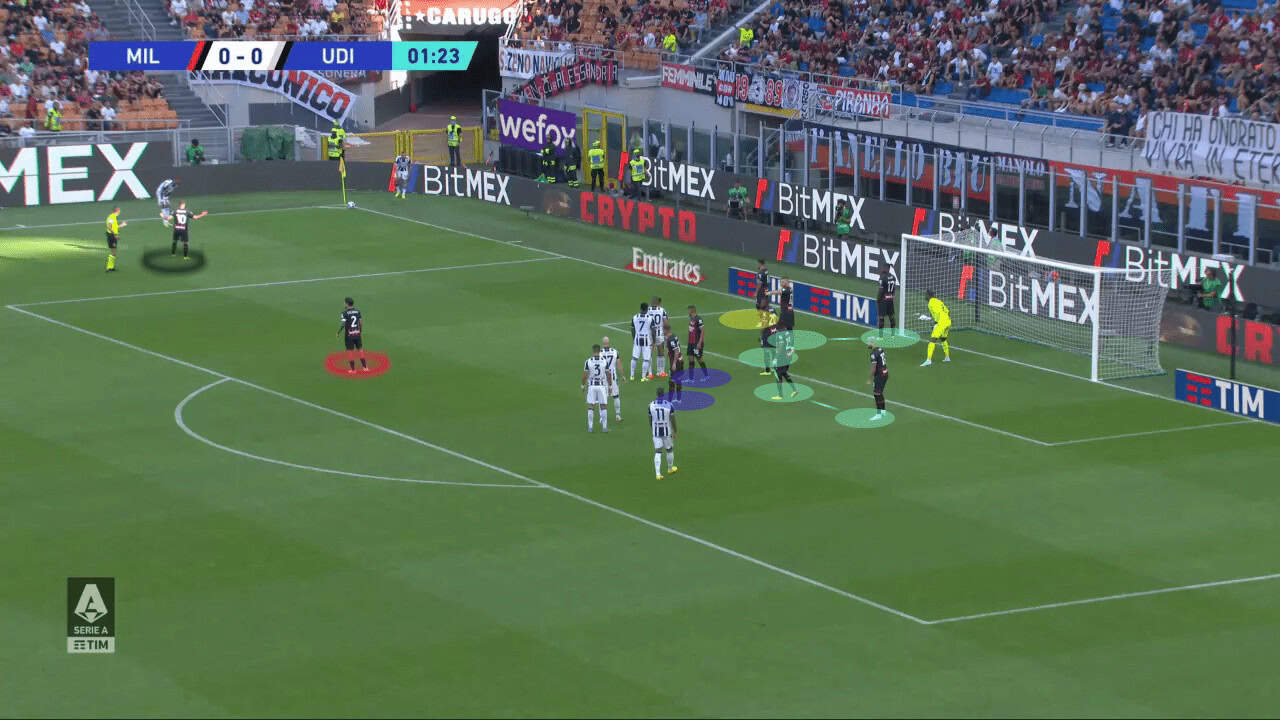
For out-swinging corners, Milan opted for this structure displayed in the lower image which involved the same duties but with a different alignment of the first-zone defensive line (highlighted in green), which was more slanted towards the outside.
The other positions stay the same. The yellow-marked player covers this area to intercept the first touch and moves to the near post if required to support the blue-marked player. Meanwhile, the two red-marked players are man-markers and the black-marked player is ready for the rebound.
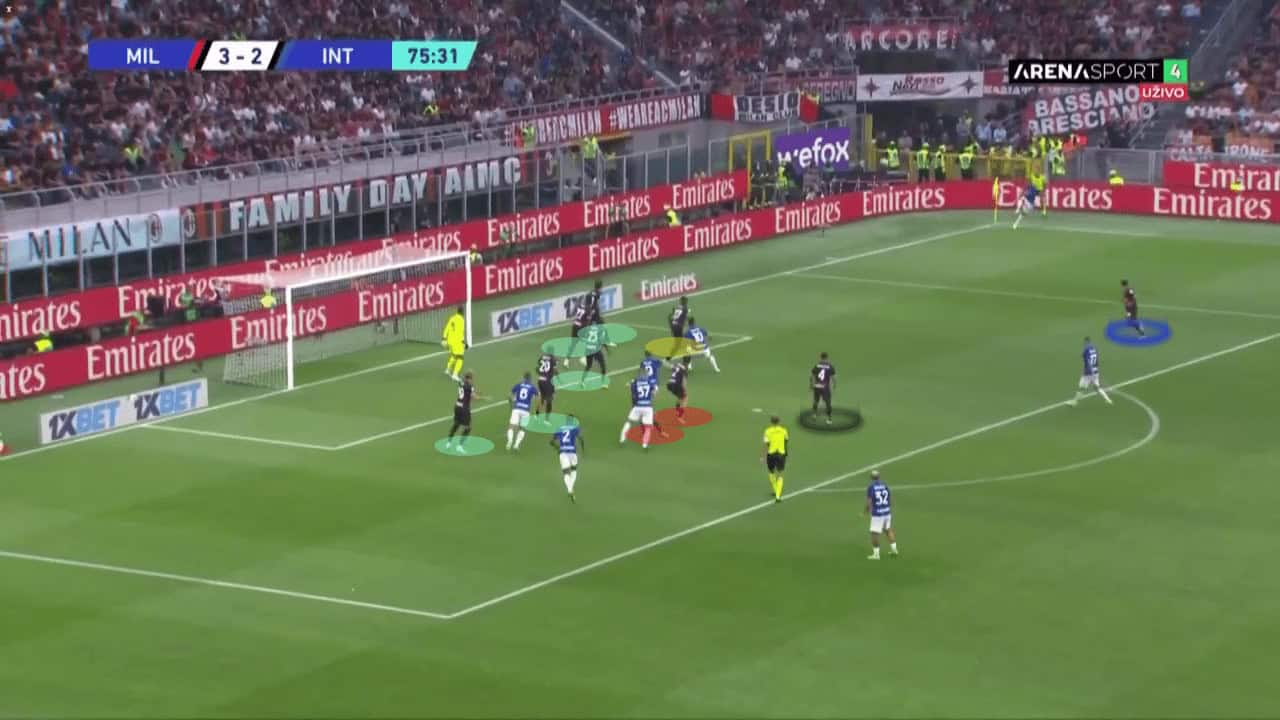
Now that we know the system well, we can return to the Udinese match where the first problem appeared in it — Udinese’s exploitation of the existence of only two man-markers to track the runners.
They made all five of their runners start in front of the two man-markers and no one started behind the defensive first-zone line. Therefore, there are five runners against two man-markers. There are three free players, one of whom is the one who scored the goal.
In the first picture below, Nehuén Pérez (18) moves with the green arrow, pulling one of the man-markers with him, moving in front of Ismaël Bennacer with the yellow arrow to attract him forward a little so that Rodrigo Becão (50) who is free from surveillance moves with the blue arrow in that space.
In the second picture, the roles of the other three runners appear, where Isaac Success (7) moves with the yellow arrow behind Ante Rebić (12) to take his attention away from the targeted area in front of him, Bram Nuytinck (17) moves in the blue arrow behind Pierre Kalulu (20) attracting his attention, pulling his marker with him.
The player with the green arrow without marking goes to the far post in case the header goes there. The result is a goal as shown in the third and fourth photos.
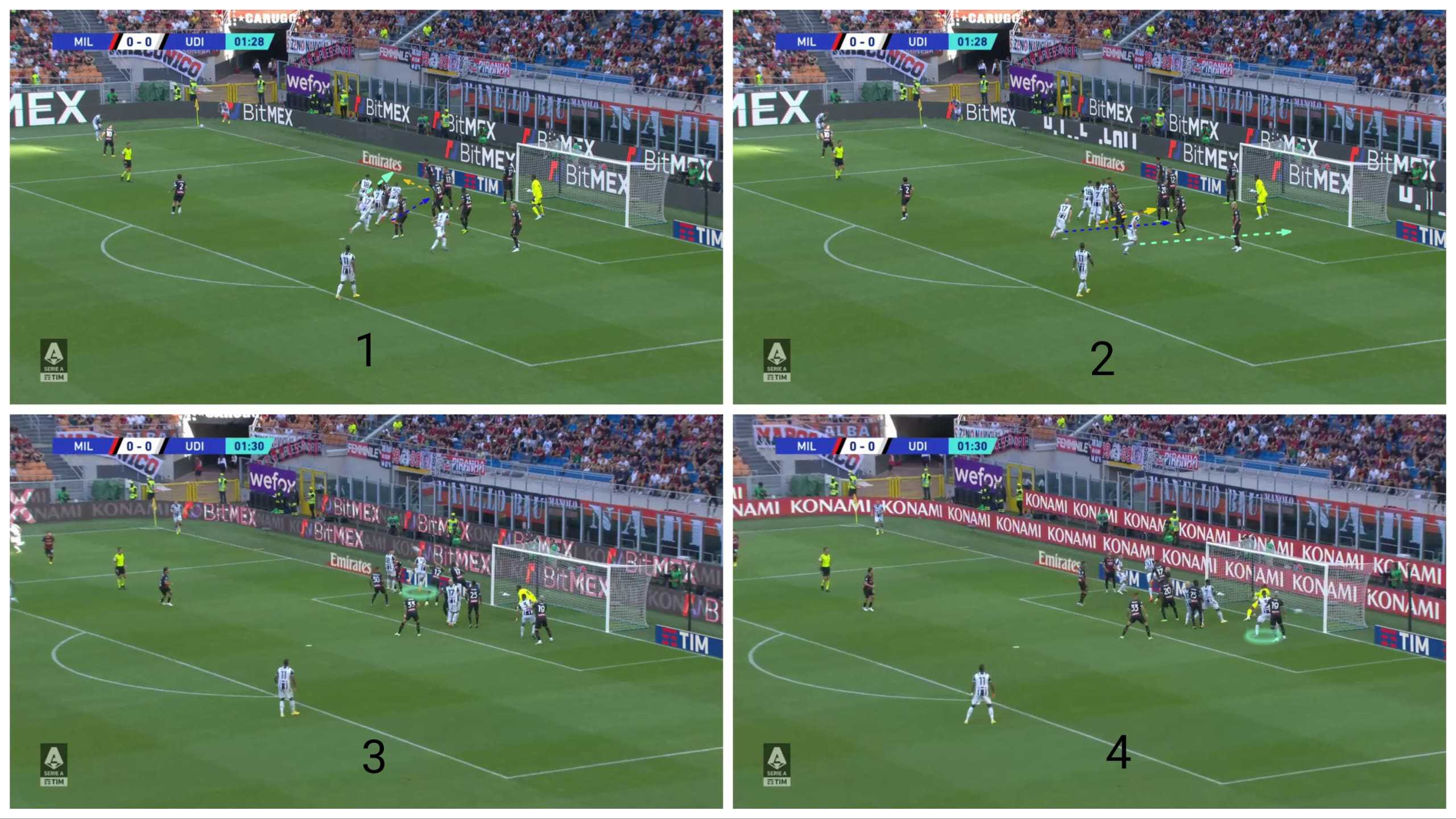
Near post
Milan then decided to change something in this system to increase the number of man-markers. They decided to dispose of the player who was standing in front of the first zonal line on the near post and go to the short corner if it happened (as explained above) and replace him with an additional man-marker, especially in the out-swinging corners.
Therefore, the shape became as shown in the first picture with five players in the first-zone line in green, three man-markers in yellow, a player in red for the rebound and a player in blue for the short corner if it happened. Here, another problem appeared and it was like playing chess when Sassuolo exploited this as shown in the second picture.
The targeted area was between the first two zonal players of the first zonal line as shown in green. The yellow player started from the blind side behind them next to Olivier Giroud to force him to stand in front of him and not approach his colleague who was in front of him so that the space remained large. When executing, he moved into this space, which became overloaded. The result was a goal as shown in the third and fourth pictures.
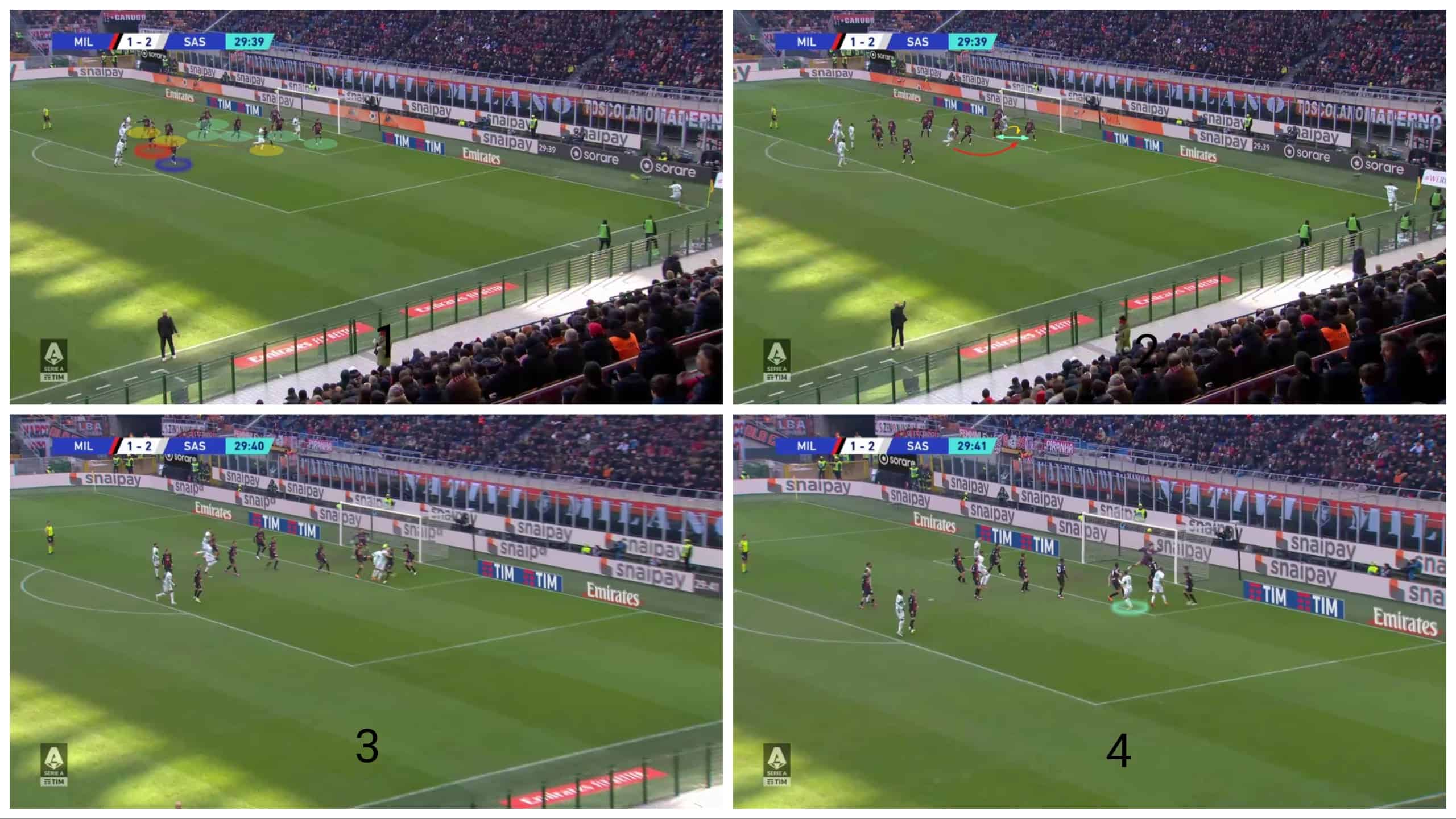
The area in front of the zonal line
Milan then decided to revert to their previous system to safeguard the near post but reduced the gaps between the players of the first-zone line. Here, in the game against Inter in Serie A on the fifth of February, the old system came back as follows: five players in green forming a defensive zone line, a player ahead of them with a yellow arrow on the near post to guard against flicks, intercept the first touch and move to the short corner if it happened, two players in red man-marking, a player in blue for the short corner, and a player highlighted in black for the rebound.
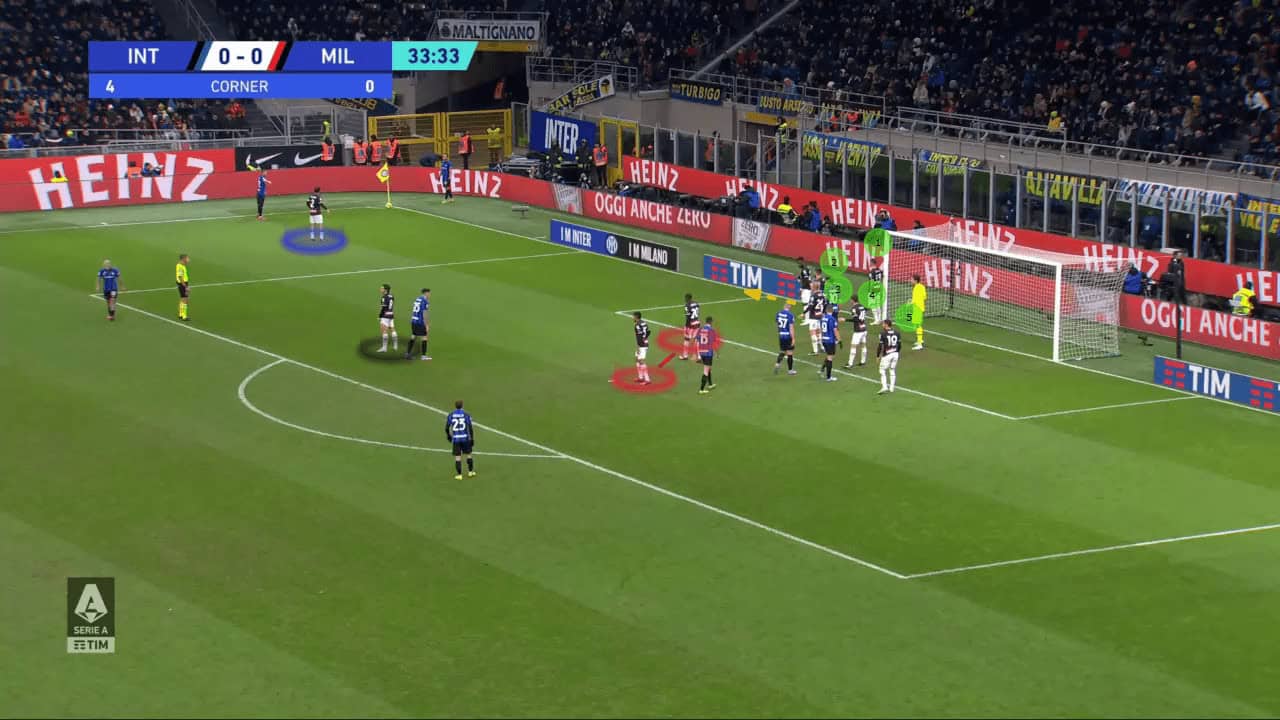
In this case, Inter found a gap in the system, which was that since they could not break through the compact defensive line, they would use the space in front of it by blocking the players of the first zone line and using the space in front of it on the edge of the six-yard box.
In the first image below, Alessandro Bastoni is shown with a green arrow moving to the near post, leaving behind the targeted space that Lautaro Martínez would run into with a yellow arrow, starting from behind the zone line, leaving Milan’s second marker alone at the penalty spot.
He had no one to mark and this was facilitated by having two Inter players on the rebound zone to distract him. In the same image, we also indicate that there were only three Milan players in black who could reach the ball before it got to Lautaro on the edge of the six-yard box — they were Olivier Giroud, Divock Origi and Simon Kjær.
In the second picture, the role of three Inter runners in black comes to block three Milan players as shown in the third picture and the space was cleared for Lautaro who scored the goal in the fourth image.
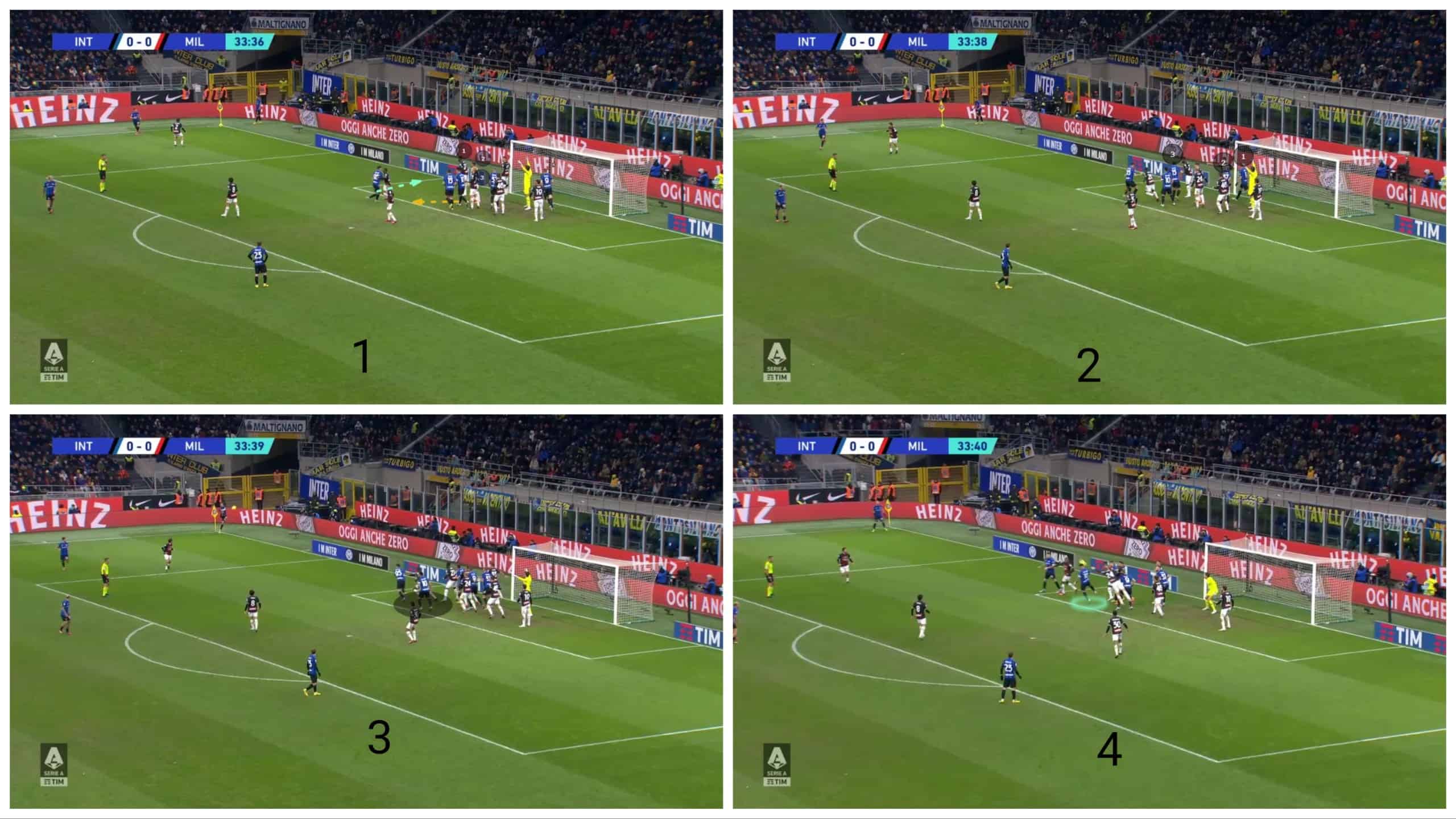
Leaving a player for the counter-attack
Milan then experimented with another method against Napoli in the second leg of the Champions League quarter-final, which involved having four defenders forming a zone line in green, three markers in yellow, a player in black for the short corner, a player in blue for the rebound and a player, out of shot, for the counter-attack to make the opponent decrease the number of attackers in corners and the system seemed good. However, in the second image, Milan played against Inter in the first leg of the Champions League semi-final using the same system.
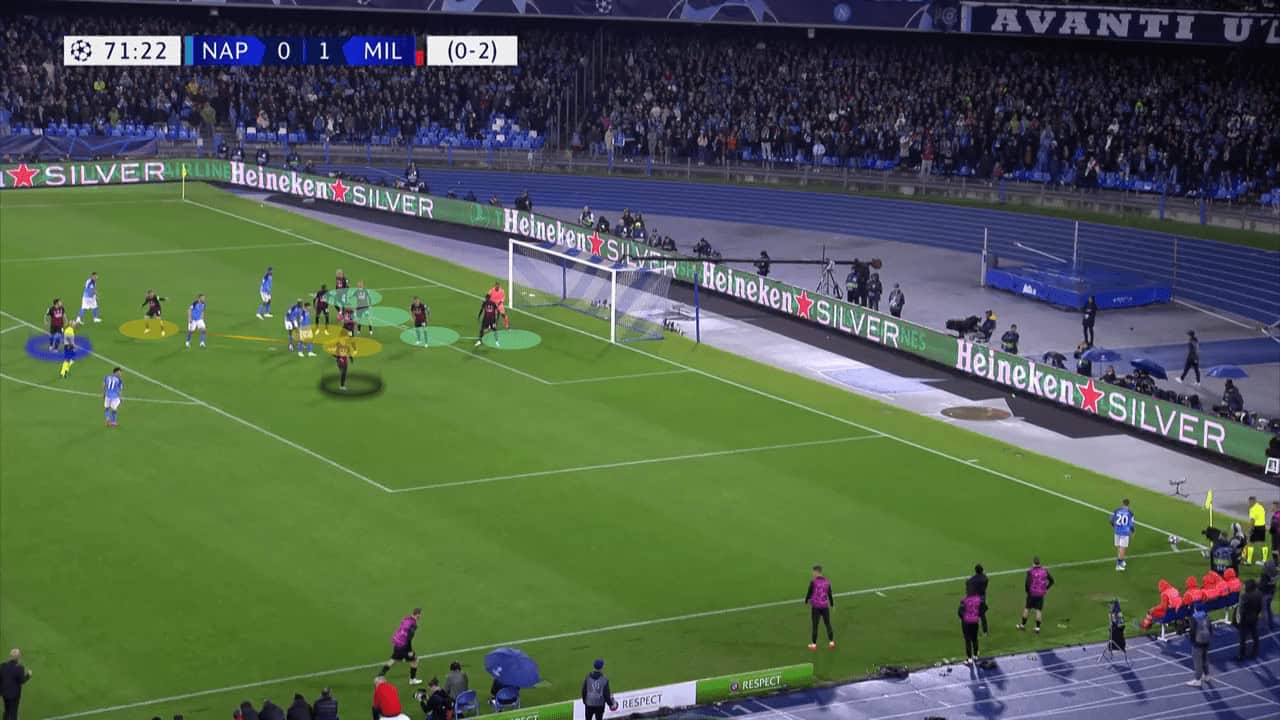
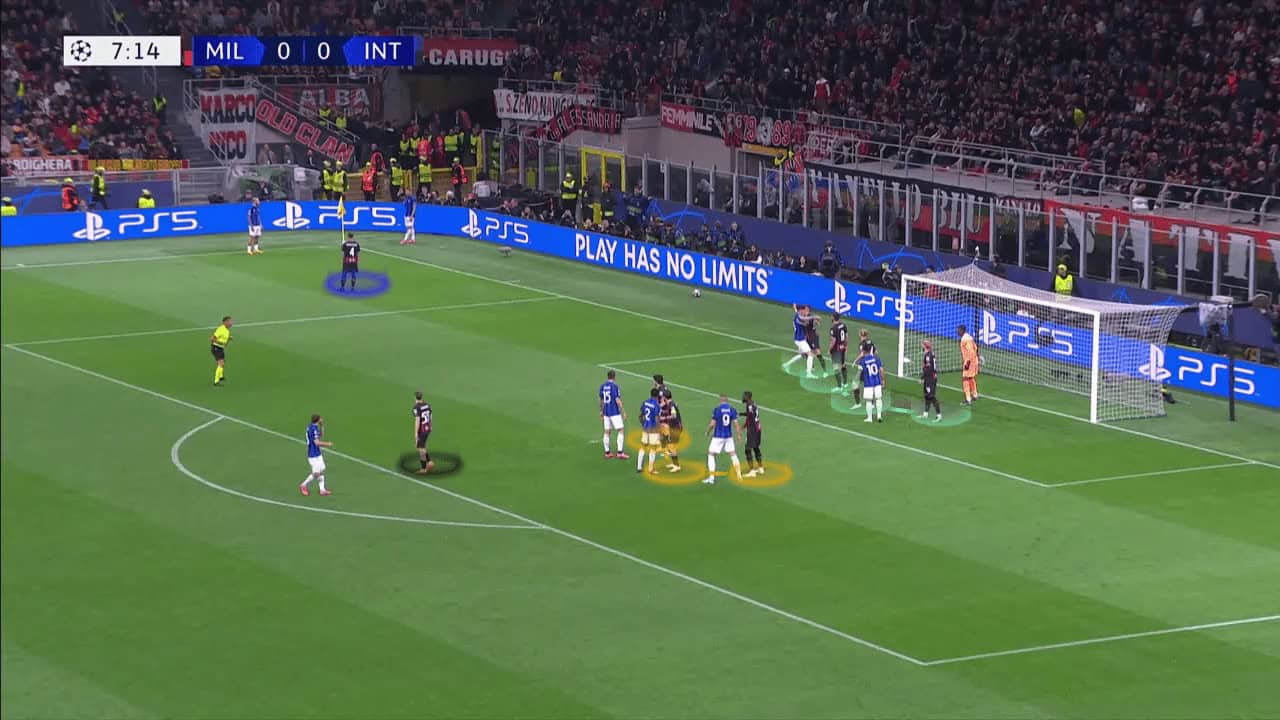
As illustrated in the first image below, Inter’s idea was that their three runners started away from the zone line to drag the markers and exploit the space between them and the zonal defensive line. Here, Džeko took advantage of Denzel Dumfries and they stood in a stack to facilitate Dumfries’ screening of Fikayo Tomori who was supposed to mark Džeko.
In the second image, the screen appears in green and Davide Calabria (highlighted in yellow) finds himself facing Džeko. This is what we call a mismatch because Džeko is stronger than him individually in aerial duels. Meanwhile, Acerbi in black goes to the near post away from the targeted area.
In the third image, Lautaro’s role comes with the yellow arrow to push Theo Hernández slightly away from the targeted area behind him because they become only four in the zonal line and, therefore, the shaded space become empty in the fourth photo, but the ball was played incorrectly behind Džeko who exploited the mismatch.
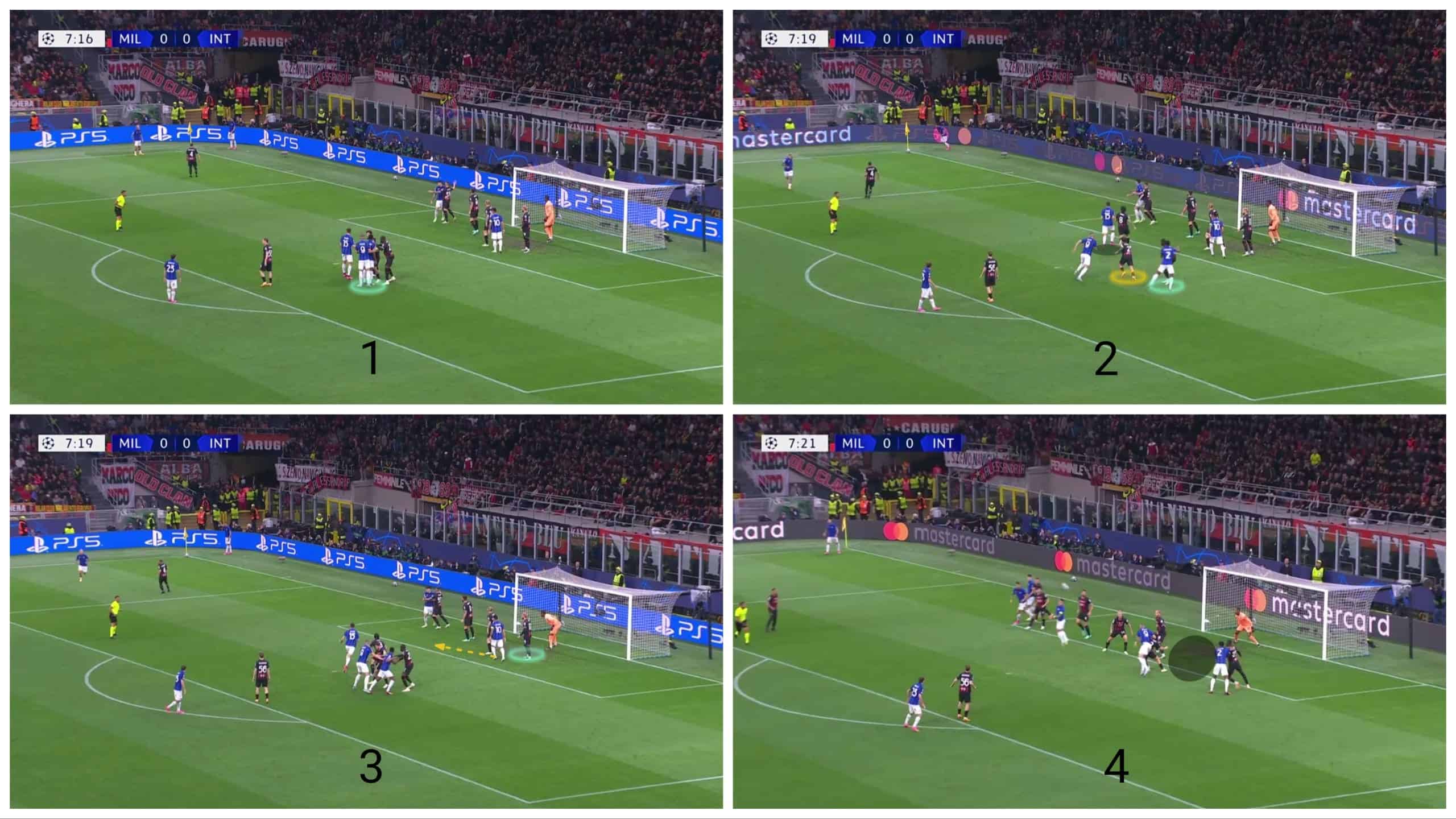
Milan still fluctuates in choosing their defensive system for corners. Recently, Milan have changed their method to a man-marking system with only two zonal defenders in green, a player in black for the short corner and a player who is highlighted in yellow in the rebound zone as shown below in the last two matches.
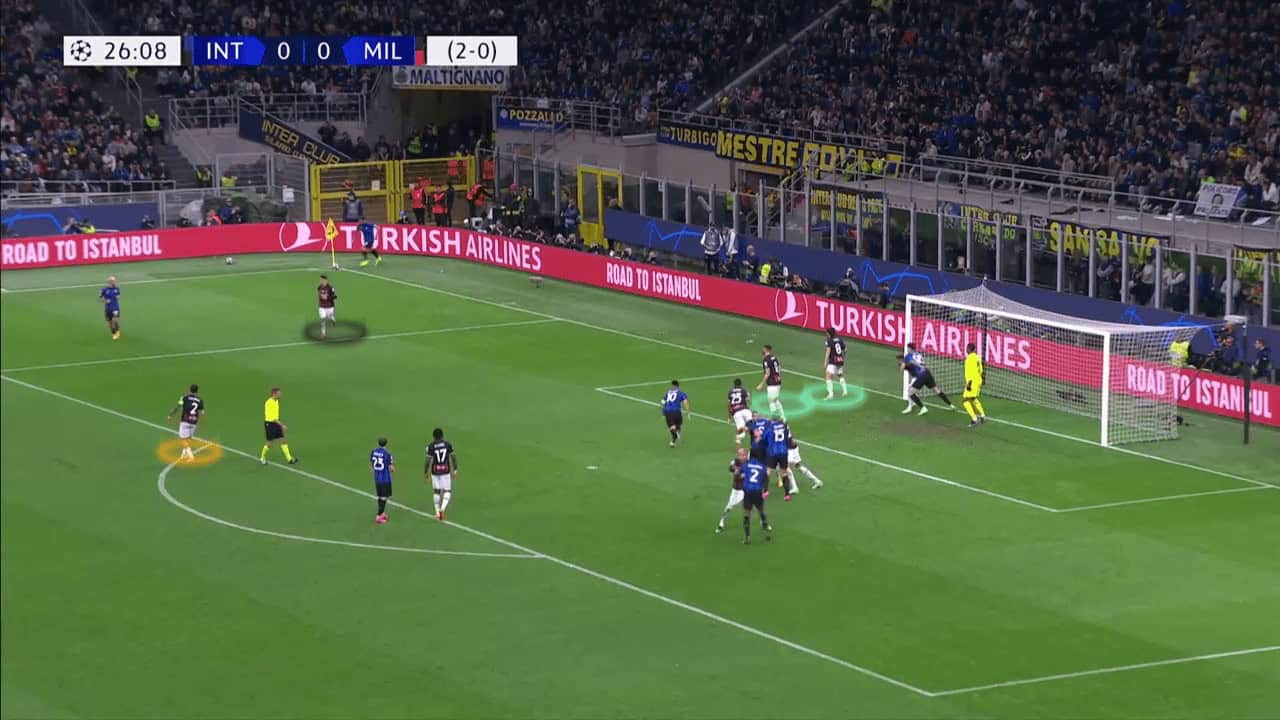
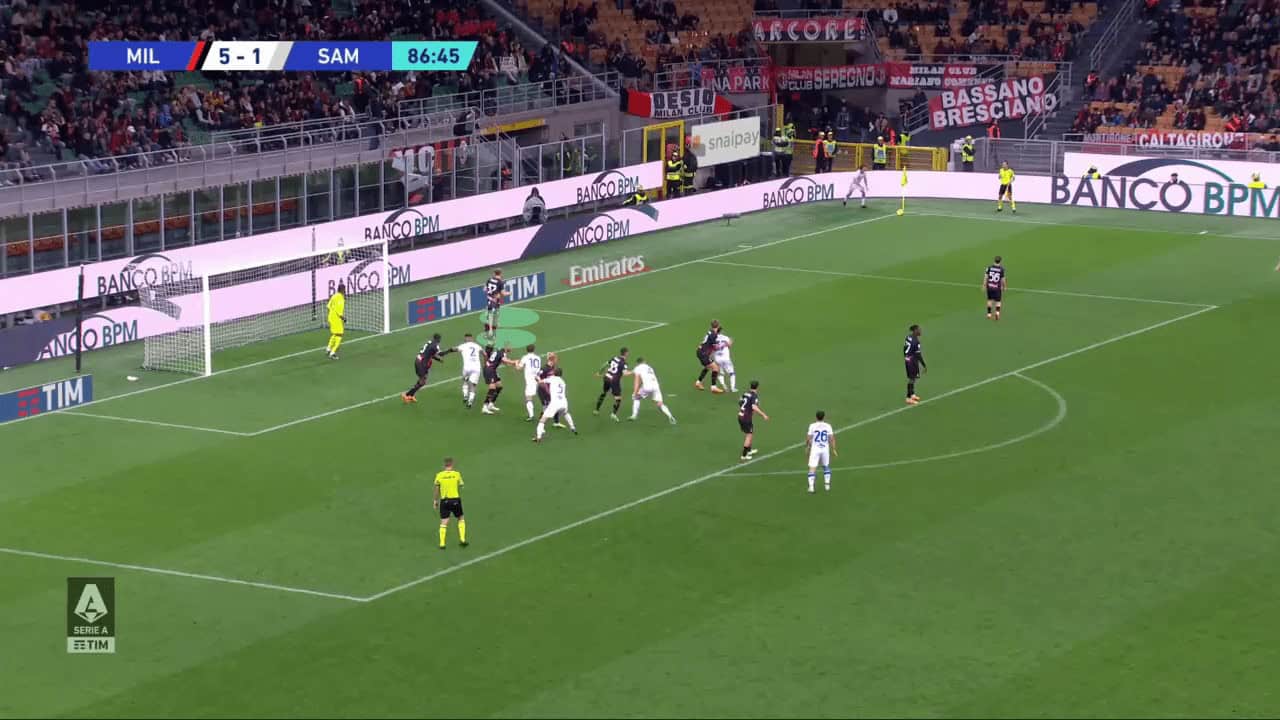
Conclusion
This analysis illustrates how Milan struggled in conceding corner kicks this season and the causes of that hardship which compelled Milan to alter the defensive strategy in corners.
The reason for the ineffectiveness of Milan’s hybrid system is the behaviour of the players of the zonal line based on the opponent’s reference, which leads to the ease of leaving their positions even slightly, knowing that shifting is so dangerous in the zone defence in corners. The second reason is that the man-markers are pulled to mark the opponents very far from their defensive line.
Milan has exhibited variability in their defensive strategy in corners this season. After starting with the hybrid system and adjusting it considerably, they switched to a man-marking system. Let us observe whether this will benefit them.

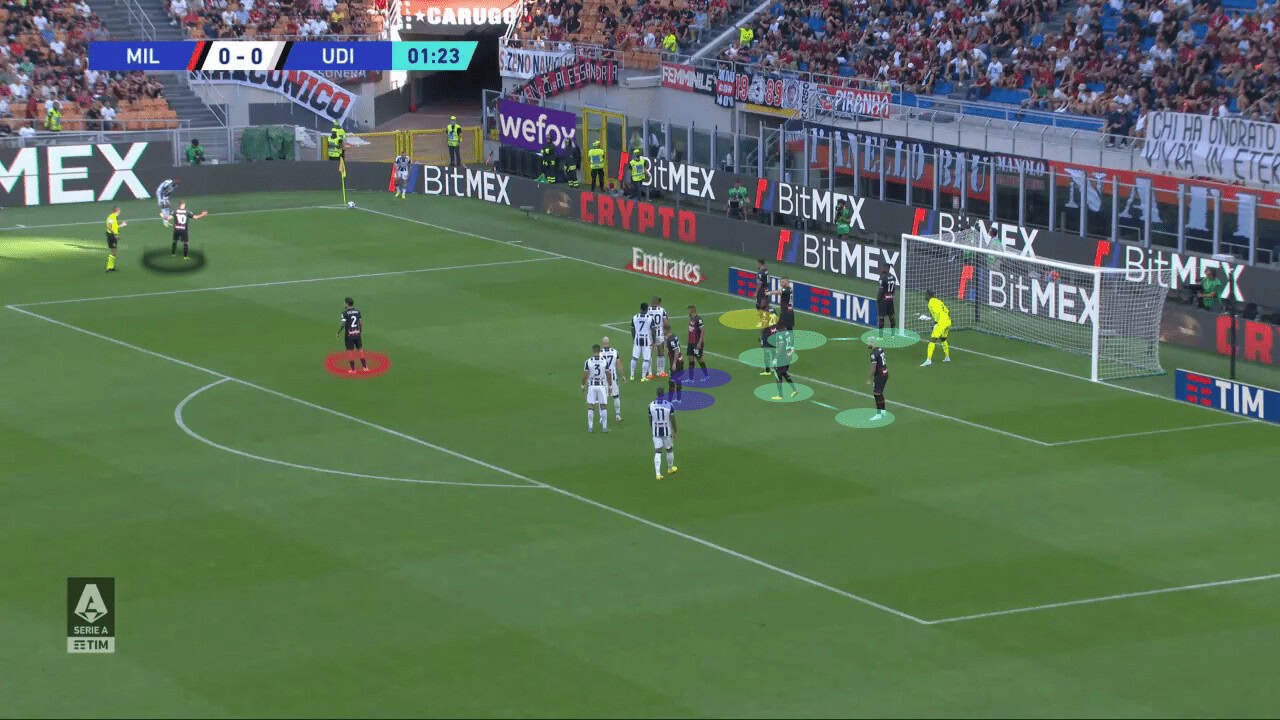




Comments